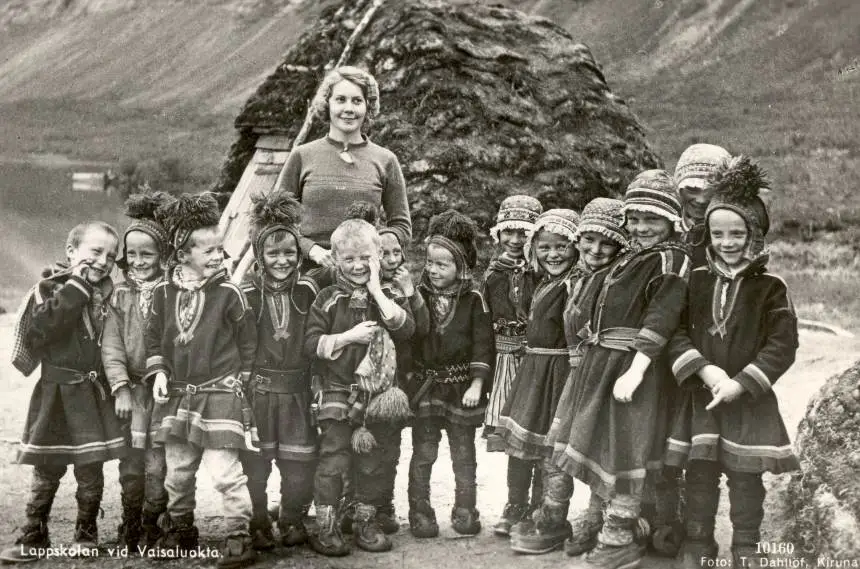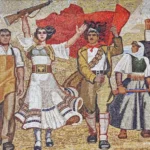Sami’s Historical Context
Spanning across the northern regions of Norway, Sweden, Finland, and Russia’s Kola Peninsula, Sami identity has thrived for thousands of years. This indigenous population, with its rich cultural tapestry, has been subjected to numerous misconceptions throughout history.
Dominant narratives have frequently typecast them as mere nomadic reindeer herders, obscuring the true breadth of Sami identity. Such a portrayal has often been at the expense of understanding the multifaceted aspects of their lives. Beyond the simplistic view of herding, the Sami people have a wide range of traditions, practices, and livelihoods that resonate deeply with their homeland.
By relegating them to a singular activity, historical accounts have inadvertently stripped away the nuances of their connection to the land. The label of ‘homeless’, in particular, has been a profound mischaracterization. Far from being indifferent wanderers, the Sami have historically exhibited a tangible, emotional bond with their ancestral territories.
This connection encompasses not just their economic activities but also their cultural, spiritual, and communal essence. Unraveling the Sami identity means peeling back the layers of historical representation to appreciate the depth and complexity of their relationship with their homeland.
Challenging the ‘Homeless’ Notion
The predominant perception of the Sami people has been deeply influenced by misconceptions, notably the idea of them as detached wanderers. This image presents the Sami as if they lack a genuine attachment to their territories, drifting wherever their reindeer roamed. Such a portrayal might seem romantic to some, but it’s a glaring departure from the truth.
Historical records, especially from the late 19th century, offer a corrective lens to this skewed perspective. One notable voice that counters this prevailing myth is from a Sami Bailiff in Norrbotten County, Frans Forsström. In 1892, Forsström penned a letter to the provincial court in which he highlighted the profound connection the Sami had with their territories. Contrary to the ‘homeless’ stereotype, he stated unequivocally that the Sami held as much affection for their fatherland as any other resident populations.
These revelations not only underscore the Sami’s deep bond with their homeland but also illuminate the multifaceted relationship they’ve always had with their surroundings. Beyond just finding pasture for their reindeer, the Sami have cultivated memories, traditions, and a distinct sense of belonging in these lands. Such documents remind us of the need to revisit and rectify the distorted narratives that have long overshadowed the rich tapestry of the Sami’s relationship with their homeland.
Place and Identity in Sami History
The multifaceted relationship between the Sami and their environment goes beyond simplistic notions of nomadic life. To categorize them solely as wandering nomads is to skim the surface of their profound bond with the lands they inhabited. Historical delvings paint a more nuanced picture, showing the depth of the Sami’s connection to place.
Digging into archival sources, one discovers evidence that the Sami’s commitment to their territories was multi-dimensional. It wasn’t merely about finding grazing grounds for their reindeer, but it revolved around a sense of belonging, rootedness, and identity. These weren’t just lands they roamed; they were lands they deeply cherished, holding significant cultural and ancestral value.
Furthermore, tax and parish records shed light on the fact that the Sami weren’t simply attached to the broader region but had specific places within these territories where they held strong multi-generational bonds. Families returned to these special places generation after generation, indicating not just a transient connection, but a deep-seated, long-lasting bond.
This nuanced perspective unravels the simplistic view that overshadowed the Sami’s historical bond with their lands. Recognizing their multi-generational commitments provides a more accurate, respectful, and comprehensive understanding of the Sami’s intertwined relationship with their environment.
Beyond Reindeer Herding
Historically, the dominant narrative endorsed by the state pigeonholed the Sami as merely reindeer herders. This limited view overshadowed the multifaceted nature of their lives and livelihoods. Delving deeper, one uncovers that the Sami were far from being one-dimensional. Their rich tapestry of life encompassed a broad spectrum of trades, from intricate handicrafts and skilled fishing to the more recognized reindeer husbandry.
Their land was not just a grazing field but a vibrant canvas where various cultural expressions blossomed. As a result, the terrain became a living testament to the Sami’s diverse endeavors. This versatility in livelihoods led to profound people-place interactions. The landscape, dotted with significant landmarks, bore evidence to their deep-seated cultural practices. Named locations, evocative storytelling traditions, and a strong sense of place identity emerged from these interactions.
These myriad engagements on their lands challenge the narrow, state-propagated image. They underscore the need to view the Sami not just through the prism of reindeer husbandry but as a people with diverse trades and a rich cultural heritage. This broader understanding is crucial to appreciate the intricate weave of their history, cultural identity, and connection to their land.
Reclaiming Saminess Today
The exploration of history isn’t just an academic endeavor; it’s a personal journey that holds power in shaping modern narratives about identity and belonging. For the Sami people, diving deep into their past offers a unique opportunity to redefine and reassert their Sami identity and place in the world. However, there’s a delicate balance to strike.
While history provides a rich tapestry of stories, connections, and evolutions, it’s crucial not to become overly tethered to it. Drawing too heavily on past narratives might inadvertently confine the fluidity of identity to static points in time.
The contemporary Sami community grapples with this challenge. On one hand, the richness of their history, filled with tales of cultural practices, connections to lands, and varied livelihoods, offers a wellspring of pride and belonging. It allows for a deeper connection to ancestors, places, and traditions that might otherwise fade with time.
Yet, on the other hand, leaning too heavily on these historical narratives can become limiting. Identifying solely based on ancestral links or past practices might create an artificial barrier, potentially separating ‘authentic’ Sami from those who don’t fit neatly into historical boxes. Such categorizations risk stifling the evolution of Sami identity, trapping it in the past and not allowing it to breathe, grow, and adapt in the present.
It’s here that the notion of ‘Saminess’ becomes most intriguing. How can one reconcile the profound depth of history with the vibrant, dynamic identity of today? It requires a blend of reverence for the past, acknowledgment of the present, and openness to the future. Understanding that while history provides roots, identity, much like a tree, grows, changes, and evolves. The challenge for the Sami, and indeed for all of us, lies in embracing the entirety of this journey.
Implications for Contemporary Sami Identity
The intricate tapestry of Sami identity, woven over centuries, holds lessons for today. The modern Sami face a world vastly different from their ancestors, but the past remains influential. The key lies in drawing strength from historical roots while adapting to today’s context.
It’s not merely about reindeer herding or ancestral ties. The current generation confronts new challenges: political representation, cultural preservation against globalization, and issues of land rights. These challenges, while shaped by history, demand contemporary solutions.
There’s a danger in oversimplifying identity based on past narratives. For the Sami, it’s not a binary choice between reindeer herding and other livelihoods. It’s about harmonizing traditions with current realities. For instance, while historical land practices inform current land rights discussions, present-day negotiations require understanding modern legal, political, and social landscapes.
Moreover, the broader Swedish society’s perceptions shape Sami experiences. Recognizing the multifaceted nature of Sami identity helps combat stereotypes and fosters mutual respect.
While history offers a foundation, the current Sami identity is a dynamic interplay of past lessons and present realities. It’s a journey of both reflection and evolution.
Concluding Thoughts on Sami Identity
The Sami narrative, deeply interwoven in a myriad of traditions, goes far beyond the commonly associated realm of reindeer herding. Their history is a testament to the profound connections to their territories, passed down through countless generations. Over the centuries, socio-political dynamics have played a role in defining and, at times, oversimplifying Sami identity.
To genuinely appreciate the Sami’s legacy and their contemporary struggles, we must approach them as a people of multifaceted histories and continuously evolving identities. By adopting this perspective, we pay homage to their past, recognize the intricacies of their present, and support their future. Such understanding paves the way for mutual respect, deeper appreciation, and a robust platform for meaningful socio-political advancements.
Adapted from an academic article for a wider audience, under license CC BY 4.0









